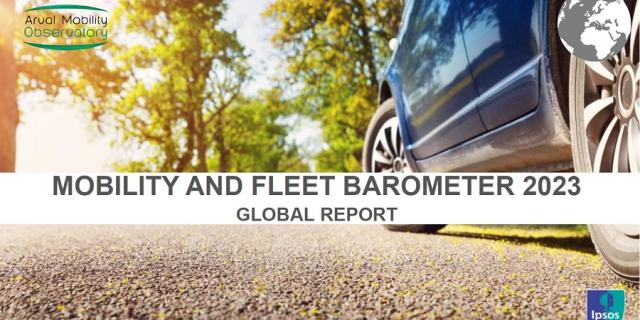The Arval Mobility Observatory publishes its Mobility and Fleet Barometer 2021
Rueil-Malmaison, 20 April 2021
The Arval Mobility Observatory, industry reference in recording and forecasting mobility trends, has published the 17th edition of its annual barometer. This year nearly 5,200 fleet managers were interviewed across 20 countries.
The Arval Mobility Observatory Mobility and Fleet Barometer 2021 puts forward five main trends:
1. Companies are more confident in the future than before the pandemic
Fleet managers remain optimistic about the future. 45% of interviewed companies anticipate an increase in the number of vehicles in their fleet over the next three years, compared to only 31% last year. However, this enthusiasm is more moderate in the smallest companies (31%) than in the largest companies (59%). The most optimistic countries are Brazil, Turkey, the Netherlands, Poland and Switzerland.
Companies anticipate growth in their business resulting in a need for company vehicles (61%), the need to provide a safe means of commute for their employees in the context of Covid-19 (29%), and HR-related needs like talent recruitment to retain employees (26%). Companies plan to offer vehicles to employees with no company car eligibility and shared vehicles (19% for both reasons).
For the 8% of companies that anticipate a reduction in their fleets, the main reasons put forward are financial considerations (impact of the Covid-19 crisis for 47%), a drop in their activity (31%) and fewer employees that will have access to company cars (22%), but there are also reasons linked to the increase in remote working (20%), the implementation of alternative mobility solutions and cash allowances (15% for both reasons) and CSR commitments (12%).
2. The shift towards electrified vehicles is accelerating at a global level
Across all countries and companies surveyed, 70% of companies have already implemented or are considering implementing at least one of the following technologies within the next three years: hybrid vehicles (HEVs), plug-in hybrids (PHEVs) and battery electric vehicles (BEVs). 39% of companies already use at least one of them. France, the Netherlands, Denmark and Finland are in the lead with more than half of companies having already implemented at least one of these technologies and almost 8 out of 10 either already having done so or intending to do so in the next three years. At the other end of the scale, in Europe, Luxembourg and the Czech Republic are using less of these technologies, and so are Russia and Turkey.
When it comes to hybrids and plug-in hybrids, almost 6 out of 10 companies are either already using them or might use them in the next 3 years, compared to 4 out of 10 a year ago. The BEV’s are also progressing, since 53% of companies might use them in the next 3 years (compared to 38% in 2020) and in 3 years’ time, 1 in 3 fleet vehicles will be BEVs.
This shift concerns all companies and all vehicle types. The reasons for this trend are mainly linked to a desire to have lower environmental impact, to reduce fuel expenses and to improve company image.
Besides environmental considerations, the other main reasons for adopting alternative energy sources are savings opportunities, including fuel economy and tax incentives, future restrictive government policies including traffic bans and, to a lesser extent, employee expectations (31% for passenger cars).
The use of BEVs is also increasing due to lower barriers to entry than last year: for those companies not yet considering using BEVs (21%), the main barriers against BEVs are the lack of public charging points (50% compared to 57% a year ago), and the purchase price of models (45% of companies compared to 56% a year ago).
3. A major increase in the use of alternative mobility solutions
71% of companies have already implemented alternative mobility solutions for their employees. Across all countries and companies surveyed, 85 % of companies have already implemented or are considering implementing at least one of them within the next three years. The Netherlands, Switzerland and Brazil are leading the way in terms of implementation but also in terms of prospects for the future.
While almost all the solutions used are clearly progressing, the ones progressing most rapidly are those that best respond to the current health crisis: mobility budgets (29% of companies are using one compared to only 14% in 2020); corporate car-sharing (28% compared to 19% in 2020).
The use of public transport is also continuing to grow, but unsurprisingly much more slowly. Shared/leased bicycles are expected to be used by 44% of companies in 3 years’ time.
In this dynamic and increasingly multimodal context, booking applications and mobility budgets are already being used or might be implemented in the next 3 years by 52% of companies and 58% of companies respectively.
4. A continuous dynamic trend for operational leasing
Operational leasing still has a bright future as a method of financing company car fleets. Nearly 61% of companies say they intend to develop it in the next three years, compared to 39% last year. Most importantly, 23% say they definitely will.
Another finding is that the proportion of vehicle leasing is expected to grow in all types of businesses, including the smallest: 41% of the smallest companies say they will develop operational leasing (compared to 31% in 2020), 62% of companies with 10 to 99 employees (34% in 2020), 74% of large companies (42% in 2020) and 79% of very large companies (52% in 2020).
5. More and more connected vehicles are being used
58% of companies have connected vehicles within their fleets, with no significant difference between passenger cars and LCVs; 48% for passenger cars and 49% for LCV fleets. The extent of these connected services increases with the size of the company: 31% for the smallest companies and 82% among the largest companies. The main reasons to have connected vehicles, regardless of type, are to locate vehicles or improve vehicle security (50%), to improve operational efficiency (42%), to improve driver safety (41%) and to reduce fleet costs (40%). Indeed, fleet managers are conscious that telematics is a key enabler to manage their fleet in an efficient way, which is even more essential during a crisis period.
“This major global survey confirms the trends observed over the past three years towards a growing interest in electrified vehicles and alternative mobility solutions. The current pandemic is encouraging fleet managers to offer their employees ever more sustainable and flexible solutions. EU regulations and local tax incentives also strengthen this need for sustainable mobility options. Flexibility feeds a need to provide a safe commute for their employees and continue to operate and make employees mobile while complying with local mobility restrictions”, comments Yaël Bennathan, Head of Arval Mobility Observatory at an international level.
Methodology 2021
For this independent survey, 5,197 Fleet Manager interviews were carried out between October 27, 2020 and January 15, 2021 by independent research company Kantar; participants were recruited by telephone and a link was sent to complete the survey online.
The scope (20 countries) includes most European countries (Austria, Germany, Belgium, Spain, France, Italy, Luxembourg, the Netherlands, Poland, Portugal, the United Kingdom, the Czech Republic, Switzerland, Finland, Denmark, Norway, Sweden) in addition to the important fleet markets of Russia, Turkey and Brazil. The companies included operated at least one vehicle.
The distribution of the interviewees was as follows:
- 33% were companies with less than 10 employees
- 20% were companies with 10 to 99 employees
- 27% were companies with 100 to 249/499/999* employees (*dependent on market)
- 20% were companies with 250/500/1000* employees or more (*dependent on market)










